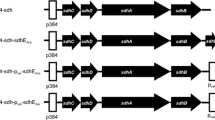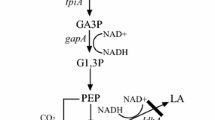Abstract
Succinic acid is excreted during anaerobiosis by many bacteria, and manifold applications are known making the biotechnological production of succinate attractive. Although the pathways for succinate formation are known, succinate export is not understood in most of the succinate producing bacteria. Here, we present a bioinformatic approach for identification of a putative succinate export system in Corynebacterium glutamicum. The subsequent screening revealed that a mutant in the gene cg2425 is impaired in succinate production or transport under anaerobic conditions. A function of the Cg2425 protein as import system was excluded. In contrast, a role of the Cg2425 protein as succinate export system was indicated by accumulation of increased amounts of internal succinate under anaerobic conditions in a Cg2425-dependent manner and a concomitant impairment of external succinate accumulation. In conclusion, we propose that Cg2425 participates in succinate export in C. glutamicum and suggest the name SucE for the protein.




Similar content being viewed by others
References
Abe K, Hayashi H, Maloney PC (1996) Exchange of aspartate and alanine. Mechanism for development of a proton-motive force in bacteria. J Biol Chem 271(6):3079–3084
Altschul SF, Madden TL, Schaffer AA, Zhang J, Zhang Z, Miller W, Lipman DJ (1997) Gapped Blast and PSI-Blast: a new generation of protein database search programs. Nucleic Acids Res 25(17):3389–3402
Anantharaman V, Koonin EV, Aravind L (2001) Regulatory potential, phyletic distribution and evolution of ancient, intracellular small-molecule-binding domains. J Mol Biol 307(5):1271–1292
Beckers G, Nolden L, Burkovski A (2001) Glutamate synthase of Corynebacterium glutamicum is not essential for glutamate synthesis and is regulated by the nitrogen status. Microbiology 147(Pt 11):2961–2970
Belitsky BR, Gustafsson MC, Sonenshein AL, Von Wachenfeldt C (1997) An lrp-like gene of Bacillus subtilis involved in branched-chain amino acid transport. J Bacteriol 179(17):5448–5457
Bott M, Niebisch A (2003) The respiratory chain of Corynebacterium glutamicum. J Biotechnol 104(1–3):129–153
Copeland A, Lucas S, Lapidus A, Barry K, Glavina del Rio T, Dalin E, Tice H, Pitluck S, Lowry S, Clum A, Schmutz J, Larimer F, Land M, Hauser L, Kyrpides N, Ivanova N, Vieille C, Richardson P (2010) Complete genome sequence of Actinobacillus succinogenes 130Z. NCBI, National Center for Biotechnology Information
Follmann M, Becker M, Ochrombel I, Ott V, Krämer R, Marin K (2009a) Potassium transport in Corynebacterium glutamicum is facilitated by the putative channel protein CglK, which is essential for pH homeostasis and growth at acidic pH. J Bacteriol 191(9):2944–2952
Follmann M, Ochrombel I, Krämer R, Trötschel C, Poetsch A, Rückert C, Hüser A, Persicke M, Seiferling D, Kalinowski J, Marin K (2009b) Functional genomics of ph homeostasis in Corynebacterium glutamicum revealed novel links between pH response, oxidative stress, iron homeostasis and methionine synthesis. BMC Genomics 10:621
Golby P, Kelly DJ, Guest JR, Andrews SC (1998) Topological analysis of DcuA, an anaerobic c4-dicarboxylate transporter of Escherichia coli. J Bacteriol 180(18):4821–4827
Grant SG, Jessee J, Bloom FR, Hanahan D (1990) Differential plasmid rescue from transgenic mouse DNAs into Escherichia coli methylation-restriction mutants. Proc Natl Acad Sci USA 87(12):4645–4649
Hall TA (1999) Bioedit: a user-friendly biological sequence alignment editor and analysis program for Windows 95/98/NT. Nucl Acids Symp 41:95–98
Hong SH, Kim JS, Lee SY, In YH, Choi SS, Rih JK, Kim CH, Jeong H, Hur CG, Kim JJ (2004) The genome sequence of the capnophilic rumen bacterium Mannheimia succiniciproducens. Nat Biotechnol 22(10):1275–1281
Inui M, Murakami S, Okino S, Kawaguchi H, Vertes AA, Yukawa H (2004) Metabolic analysis of Corynebacterium glutamicum during lactate and succinate productions under oxygen deprivation conditions. J Mol Microbiol Biotechnol 7(4):182–196
Jakoby M, Ngouoto-Nkili CE, Burkovski A (1999) Construction and application of new Corynebacterium glutamicum vectors. Biotechnol Tech 13:437–441
Janausch IG, Zientz E, Tran QH, Kroger A, Unden G (2002) C4-dicarboxylate carriers and sensors in bacteria. Biochim Biophys Acta 1553(1–2):39–56
Kalinowski J, Bathe B, Bartels D, Bischoff N, Bott M, Burkovski A, Dusch N, Eggeling L, Eikmanns BJ, Gaigalat L, Goesmann A, Hartmann M, Huthmacher K, Krämer R, Linke B, McHardy AC, Meyer F, Mockel B, Pfefferle W, Pühler A, Rey DA, Rückert C, Rupp O, Sahm H, Wendisch VF, Wiegrabe I, Tauch A (2003) The complete Corynebacterium glutamicum ATCC 13032 genome sequence and its impact on the production of l-aspartate-derived amino acids and vitamins. J Biotechnol 104(1–3):5–25
Kawaguchi H, Vertes AA, Okino S, Inui M, Yukawa H (2006) Engineering of a xylose metabolic pathway in Corynebacterium glutamicum. Appl Environ Microbiol 72(5):3418–3428
Larisch C, Nakunst D, Hüser AT, Tauch A, Kalinowski J (2007) The alternative sigma factor SigB of Corynebacterium glutamicum modulates global gene expression during transition from exponential growth to stationary phase. BMC Genomics 8:4
McKinlay JB, Vieille C, Zeikus JG (2007) Prospects for a bio-based succinate industry. Appl Microbiol Biotechnol 76(4):727–740
Moon MW, Kim HJ, Oh TK, Shin CS, Lee JS, Kim SJ, Lee JK (2005) Analyses of enzyme ii gene mutants for sugar transport and heterologous expression of fructokinase gene in Corynebacterium glutamicum ATCC 13032. FEMS Microbiol Lett 244(2):259–266
Nanatani K, Fujiki T, Kanou K, Takeda-Shitaka M, Umeyama H, Ye L, Wang X, Nakajima T, Uchida T, Maloney PC, Abe K (2007) Topology of aspt, the aspartate: alanine antiporter of Tetragenococcus halophilus, determined by site-directed fluorescence labeling. J Bacteriol 189(19):7089–7097
Okino S, Noburyu R, Suda M, Jojima T, Inui M, Yukawa H (2008) An efficient succinic acid production process in a metabolically engineered Corynebacterium glutamicum strain. Appl Microbiol Biotechnol 81(3):459–464
Page RD (1996) Treeview: an application to display phylogenetic trees on personal computers. Comput Appl Biosci 12(4):357–358
Peter H, Burkovski A, Krämer R (1996) Isolation, characterization, and expression of the Corynebacterium glutamicum betP gene, encoding the transport system for the compatible solute glycine betaine. J Bacteriol 178(17):5229–5234
Puech V, Chami M, Lemassu A, Laneelle MA, Schiffler B, Gounon P, Bayan N, Benz R, Daffe M (2001) Structure of the cell envelope of corynebacteria: importance of the non-covalently bound lipids in the formation of the cell wall permeability barrier and fracture plane. Microbiology 147(Pt 5):1365–1382
Saier MH Jr, Tran CV, Barabote RD (2006) TCDB: The transporter classification database for membrane transport protein analyses and information. Nucleic Acids Res 34(Database issue):D181–186
Sangurdekar DP, Srienc F, Khodursky AB (2006) A classification based framework for quantitative description of large-scale microarray data. Genome Biol 7(4):R32
Schlösser A, Hamann A, Bossemeyer D, Schneider E, Bakker EP (1993) NAD+ binding to the Escherichia coli K(+)-uptake protein TrkA and sequence similarity between TrkA and domains of a family of dehydrogenases suggest a role for NAD+ in bacterial transport. Mol Microbiol 9(3):533–543
Schnorpfeil M, Janausch IG, Biel S, Kroger A, Unden G (2001) Generation of a proton potential by succinate dehydrogenase of bacillus subtilis functioning as a fumarate reductase. Eur J Biochem 268(10):3069–3074
Scholten E, Renz T, Thomas J (2009) Continuous cultivation approach for fermentative succinic acid production from crude glycerol by Basfia succiniciproducens DD1. Biotechnol Lett 31(12):1947–1951
Seep-Feldhaus AH, Kalinowski J, Pühler A (1991) Molecular analysis of the Corynebacterium glutamicum lysl gene involved in lysine uptake. Mol Microbiol 5(12):2995–3005
Shimizu H, Hirasawa T (2007) Production of glutamate and glutamate-related amino acids: molecular mechanism analysis and metabolic engineering. In: Wendisch VF (ed) Amino acid biosynthesis—pathways regulation and metabolic engineering. Springer, Heidelberg
Thompson JD, Gibson TJ, Higgins DG (2002) Multiple sequence alignment using ClustalW and ClustalX. In: Current protocols in bioinformatics. Wiley & Sons, New York (Chapter 2, Unit 2 3). doi:10.1002/0471250953.bi0203s00
Trötschel C, Follmann M, Nettekoven JA, Mohrbach T, Forrest LR, Burkovski A, Marin K, Krämer R (2008) Methionine uptake in Corynebacterium glutamicum by MetQNI and by MetPS, a novel methionine and alanine importer of the NSS neurotransmitter transporter family. Biochemistry 47(48):12698–12709
Wittmann C, Becker J (2007) The l-lysin story: from metabolic pathways to industrial production. In: Wendisch VF (ed) Amino acid biosynthesis—pathways regulation and metabolic engineering. Springer, Heidelberg
Youn JW, Jolkver E, Kramer R, Marin K, Wendisch VF (2008) Identification and characterization of the dicarboxylate uptake system DccT in Corynebacterium glutamicum. J Bacteriol 190(19):6458–6466
Youn JW, Jolkver E, Kramer R, Marin K, Wendisch VF (2009) Characterization of the dicarboxylate transporter DctA in Corynebacterium glutamicum. J Bacteriol 191(17):5480–5488
Zeikus JG, Jain MK, Elankovan P (1999) Biotechnology of succinic acid production and markets for derived industrial products. Appl Microbiol Biotechnol 51:545–552
Acknowledgments
The excellent technical assistance of Anja Wittmann is acknowledged. The financial support by the BMBF (grant 0313805H; GenoMik Plus) and the Max Planck Society to EJ is gratefully acknowledged. The sdh mutant was kindly provided by Dr. Jung-Won Youn, University of Bielefeld.
Author information
Authors and Affiliations
Corresponding author
Additional information
Stephanie Huhn and Elena Jolkver contributed equally.
Electronic supplementary material
Below is the link to the electronic supplementary material.
Table S1
Bacteria, plasmids and primers used in this study (PDF 16 kb)
Table S2
List of C. glutamicum genes encoding proteins identified by the comparative genome analysis of C. glutamicum, Actinobacillus succinigenes and M. succiniciproducens. The locus tag according to the annotation of NC_009655, known or predicted functions, number of transmembrane domains (TMD) as well as the transporter class according to the transporter classification data base TCDB are listed. Genes labelled by an asterisk were inactivated by insertion mutagenesis (PDF 9 kb)
Rights and permissions
About this article
Cite this article
Huhn, S., Jolkver, E., Krämer, R. et al. Identification of the membrane protein SucE and its role in succinate transport in Corynebacterium glutamicum . Appl Microbiol Biotechnol 89, 327–335 (2011). https://doi.org/10.1007/s00253-010-2855-1
Received:
Revised:
Accepted:
Published:
Issue Date:
DOI: https://doi.org/10.1007/s00253-010-2855-1




